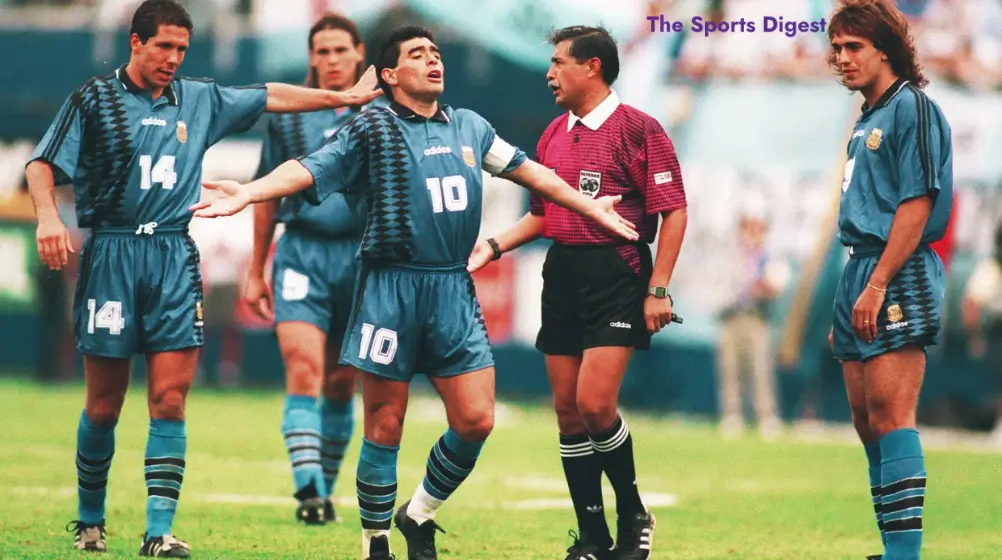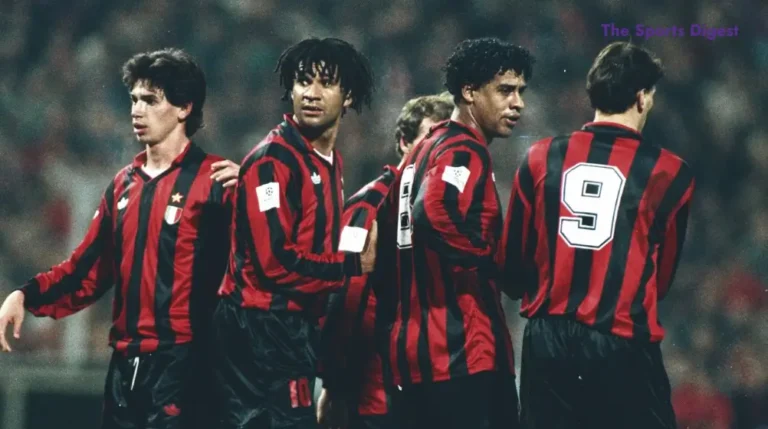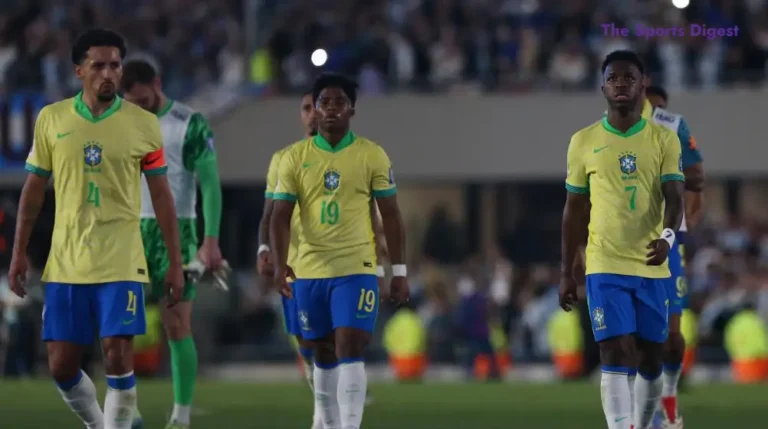World Cup 1994: Maradona’s Fall from Grace
Between Italia ’90 and USA ’94, my relationship with football underwent a seismic shift. As I transitioned from wide-eyed teenager to young adult, the innocent passion that had defined my childhood began to wane. Work commitments encroached on viewing time, while the commercialization of English football—with its newly formed Premier League and influx of television money—created a growing sense of disconnect from the game I had once worshipped without question. The World Cup 1994, held in the United States, only deepened this feeling. With its unfamiliar setting, soaring temperatures, and the absence of my beloved England, the tournament felt strangely distant, reinforcing my evolving detachment from the sport.
Yet one figure continued to command my attention across this divide: Diego Armando Maradona. The Argentine genius who had dominated my football consciousness since Mexico ’86 remained compelling even as my enthusiasm for the wider sport diminished. His journey from messiah to pariah and back again transcended football itself, becoming something closer to mythology.
Table of Contents
The Fall After Italia ’90: World Cup 1994
The four years following Italia ’90 had not been kind to Maradona. His golden era at Napoli collapsed under the weight of scandal, with rumors of mafia connections swirling alongside increasingly credible reports of substance abuse. The whispers became undeniable reality in March 1991 when he tested positive for cocaine and received a 15-month ban from football.
What followed was a period of chaotic decline. The man who had once been football’s undisputed king now appeared as a cautionary tale—the fallen angel of our title. His physique changed, his reputation suffered, and the magical aura that had once seemed permanent began to fade.
Hope of Redemption: World Cup 1994
Yet football loves nothing more than redemption, and by 1993, Maradona was staging what many hoped would be his comeback tour. Brief, unfulfilling spells at Sevilla and Newell’s Old Boys kept the flame flickering, if dimly. Meanwhile, Argentina—the team he had carried to World Cup glory in 1986 and to the final in 1990—was struggling without him.
The Albiceleste’s qualification campaign for USA ’94 teetered on disaster. Consecutive defeats to Colombia (including a humiliating 5-0 loss in Buenos Aires) and a draw with Australia in their playoff first leg left Argentina facing the unthinkable: missing their first World Cup since 1970. Public demand for Maradona’s return reached fever pitch. The prodigal son was summoned home, and his presence helped steady the ship as Argentina secured qualification with a 1-0 win in the second leg.
USA ’94: A Tournament Without Soul?
I approached USA ’94 with considerable skepticism. The decision to award football’s greatest tournament to a nation where the sport ranked somewhere below basketball, baseball, American football, and possibly even ice hockey seemed misguided at best. FIFA’s transparent commercial motivations—breaking into the lucrative North American market—did little to inspire confidence.
The rebranding of football as “soccer” and the misguided attempts to Americanize the game (there was serious discussion about widening the goals and eliminating draws) reinforced my growing cynicism. Yet as the tournament approached, one storyline began to pierce my indifference: Maradona’s last dance.
Troubling Omens: World Cup 1994
The build-up to Maradona’s USA ’94 campaign was far from smooth. Initially, he had withdrawn from the squad citing the immense pressure he was under, before a change of heart brought him back into the fold. More disturbing was an incident outside his home in Buenos Aires, where he fired an air rifle at journalists, injuring several. This hardly suggested a man at peace with himself or the world.
Rumors persisted, too, that FIFA was aware of Maradona’s continued substance issues but had turned a blind eye, knowing the commercial value of having football’s most recognizable face at their American showpiece. In retrospect, these were storm clouds gathering on the horizon.
One Last Moment of Magic: World Cup 1994
Argentina’s opening game against Greece remains etched in my memory. Maradona, visibly heavier than in his prime but still commanding the stage, had adapted his game. No longer the slalom-running virtuoso of ’86, he had reinvented himself as a more stationary playmaker, orchestrating from deeper positions.
Then came the moment—a goal that briefly rekindled my childlike wonder. Receiving the ball at the edge of the area, Maradona exchanged a quick one-two before unleashing an unstoppable shot into the top corner. What followed was perhaps more memorable than the goal itself: a wild-eyed, veins-bulging celebration directly into the camera, primal and unhinged.
Watching at home, I felt a surge of the old magic. This was the Maradona I remembered, the force of nature who transcended tactical systems and technical analysis. Argentina won 4-0, and suddenly, against my better judgment, I was invested again.
The Shadow of Suspicion: World Cup 1994
The second group game against Nigeria continued the promise. Maradona provided a sublime assist for Claudio Caniggia as Argentina secured a 2-1 victory. Yet the match is remembered not for this moment of quality but for what happened afterward—Maradona being escorted from the pitch by a medical nurse for a drug test.
At the time, it seemed a curious footnote. In hindsight, it was the beginning of the end. As Maradona disappeared down the tunnel, none of us knew we were witnessing his final moments at a World Cup.
The Crushing Revelation: World Cup 1994
The news broke like a thunderclap: Maradona had tested positive for ephedrine, a banned stimulant. He was immediately expelled from the tournament. I remember the hollow feeling—similar to my reaction when Ben Johnson’s Olympic gold had been revealed as chemically enhanced years earlier. Another hero, another fall.
For me, it marked a profound shift from optimism to skepticism. If even Maradona—the player who had embodied football’s most transcendent qualities—could not be trusted, what could? The beautiful game suddenly seemed less beautiful, more tainted by human frailty and institutional corruption.
Argentina Without Its Soul: World Cup 1994
Without Maradona, Argentina collapsed. They scraped past Bulgaria in their final group game but were comprehensively outplayed by Romania in the round of 16, losing 3-2 in a game that wasn’t as close as the scoreline suggested. The team appeared rudderless, as if a vital organ had been removed.
The Legacy of a Flawed Genius: World Cup 1994
Maradona never played in another World Cup. His international career ended not with glory but with disgrace, a fact that still feels wrong given his immense contribution to football’s greatest stage. Yet somehow, this flawed finale feels appropriate for a man whose life and career defied conventional narrative.
He was neither saint nor simple villain, but something more complex—a human being of extraordinary gifts and devastating weaknesses. The line that best captures this duality came from commentator Jon Champion as Argentina exited the tournament: “Maradona—a hero, a villain, a cheat, a genius. And now, a spectator.”
For me, Maradona’s story will always be entwined with my own relationship with football. He was there at the beginning of my love affair with the game, and his fall coincided with my own disillusionment. Yet like millions around the world, I could never quite shake the spell he cast. Even in disgrace, Diego Armando Maradona remained impossibly compelling—the fallen angel who had, for a time, shown us what it looked like to touch heaven.
Have you ever read an article like this?
There are no reviews yet. Be the first one to write one.






